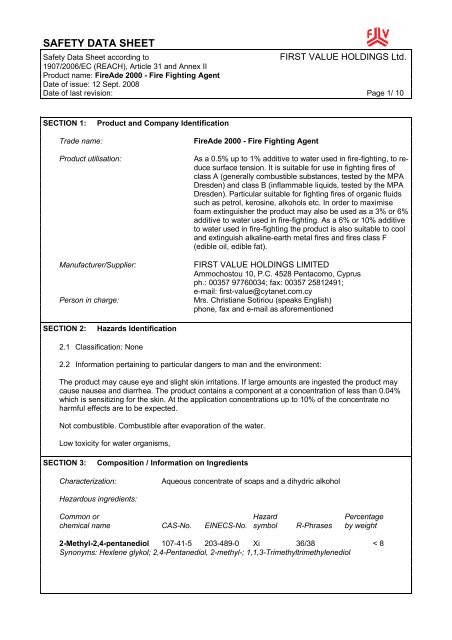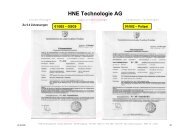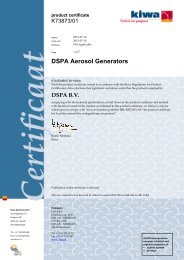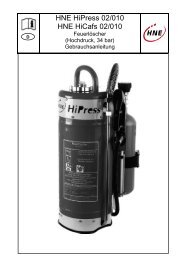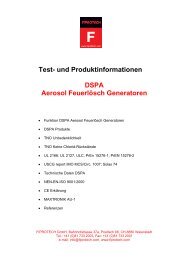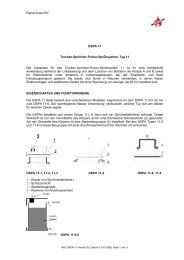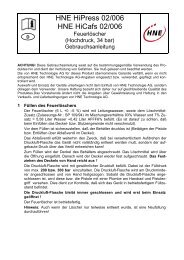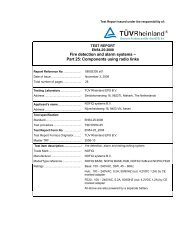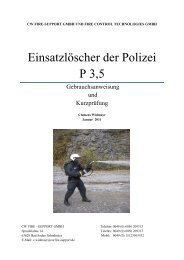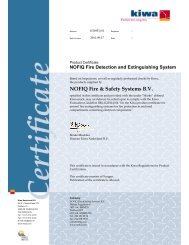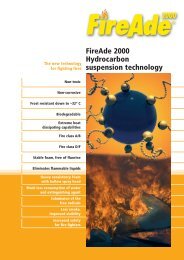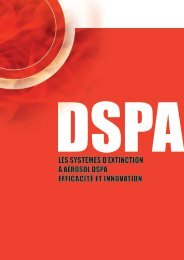SAFETY DATA SHEET - Flame Guard
SAFETY DATA SHEET - Flame Guard
SAFETY DATA SHEET - Flame Guard
You also want an ePaper? Increase the reach of your titles
YUMPU automatically turns print PDFs into web optimized ePapers that Google loves.
<strong>SAFETY</strong> <strong>DATA</strong> <strong>SHEET</strong><br />
Safety Data Sheet according to FIRST VALUE HOLDINGS Ltd.<br />
1907/2006/EC (REACH), Article 31 and Annex II<br />
Product name: FireAde 2000 - Fire Fighting Agent<br />
Date of issue: 12 Sept. 2008<br />
Date of last revision: Page 1/ 10<br />
SECTION 1: Product and Company Identification<br />
Trade name: FireAde 2000 - Fire Fighting Agent<br />
Product utilisation: As a 0.5% up to 1% additive to water used in fire-fighting, to reduce<br />
surface tension. It is suitable for use in fighting fires of<br />
class A (generally combustible substances, tested by the MPA<br />
Dresden) and class B (inflammable liquids, tested by the MPA<br />
Dresden). Particular suitable for fighting fires of organic fluids<br />
such as petrol, kerosine, alkohols etc. In order to maximise<br />
foam extinguisher the product may also be used as a 3% or 6%<br />
additive to water used in fire-fighting. As a 6% or 10% additive<br />
to water used in fire-fighting the product is also suitable to cool<br />
and extinguish alkaline-earth metal fires and fires class F<br />
(edible oil, edible fat).<br />
Manufacturer/Supplier: FIRST VALUE HOLDINGS LIMITED<br />
Ammochostou 10, P.C. 4528 Pentacomo, Cyprus<br />
ph.: 00357 97760034; fax: 00357 25812491;<br />
e-mail: first-value@cytanet.com.cy<br />
Person in charge: Mrs. Christiane Sotiriou (speaks English)<br />
phone, fax and e-mail as aforementioned<br />
SECTION 2: Hazards Identification<br />
2.1 Classification: None<br />
2.2 Information pertaining to particular dangers to man and the environment:<br />
The product may cause eye and slight skin irritations. If large amounts are ingested the product may<br />
cause nausea and diarrhea. The product contains a component at a concentration of less than 0.04%<br />
which is sensitizing for the skin. At the application concentrations up to 10% of the concentrate no<br />
harmful effects are to be expected.<br />
Not combustible. Combustible after evaporation of the water.<br />
Low toxicity for water organisms,<br />
SECTION 3: Composition / Information on Ingredients<br />
Characterization: Aqueous concentrate of soaps and a dihydric alkohol<br />
Hazardous ingredients:<br />
Common or Hazard Percentage<br />
chemical name CAS-No. EINECS-No. symbol R-Phrases by weight<br />
2-Methyl-2,4-pentanediol 107-41-5 203-489-0 Xi 36/38 < 8<br />
Synonyms: Hexlene glykol; 2,4-Pentanediol, 2-methyl-; 1,1,3-Trimethyltrimethylenediol
<strong>SAFETY</strong> <strong>DATA</strong> <strong>SHEET</strong><br />
Safety Data Sheet according to FIRST VALUE HOLDINGS Ltd.<br />
1907/2006/EC (REACH), Article 31 and Annex II<br />
Product name: FireAde 2000 - Fire Fighting Agent<br />
Date of issue: 12 Sept. 2008<br />
Date of last revision: Page 2/ 10<br />
Common or Hazard Percentage<br />
chemical name CAS-No. EINECS-No. symbol R-Phrases by weigh<br />
Polyethylene glycol,<br />
nonyl, decyl,<br />
undecyl ether 68439-46-3 not existent Xn 22-36 < 2<br />
Synonyms: C9-11 Pareth-3 (-4, -5); Alkyl (C9-11), ethoxylated<br />
Sodium decyl sulfate 142-87-0 205-568-5 Xn 22-38-41 < 0.8<br />
Synonyms: Sulfuric acid, monodecyl ester, sodiumsalt<br />
Wording of R-phrases see SECTION 16<br />
Note: The identity of the component which is sensitizing for the skin (refer to SECTION 2.2) will be<br />
disclosed on demand by a physician.<br />
Other ingredients:<br />
Common or Percentage<br />
chemical name CAS No. EINECS No. Chemical nature by weight<br />
Sodium octyl sulfate 142-31-4 205-535-5 Soap < 8<br />
Water 7732-18-5 231-791-2 No comment < 80<br />
SECTION 4: First Aid Measures<br />
General information: The following information is only relevant for the product upon delivery<br />
(concentrate). At the concentrations of application up to 10% no first-aid<br />
measures are expected to be necessary.<br />
Inhalation of aerosols: If irritations occur immediately move the affected person into fresh air. If<br />
symptoms persist seek medical attention. (Not relevant for vapours, because it<br />
is almost only water which evaporates.)<br />
Skin: Wash skin with plenty of water and soap. Change contaminated clothing. If<br />
symptoms persist seek medical attention.<br />
Eyes: Rinse with plenty of water for at least 15 minutes. Seek medical attention.<br />
Ingestion: If the patient is conscious have him rinse his mouth with water, spit it out and<br />
then have him drink water. Seek medical attention. Occurance of symptoms<br />
may be delayed.<br />
Information for doctor: If injured skin is contaminated on a large scale apply polehtylene glycol (e. g.<br />
Lutrol, PEG 400), leave it on for some minutes and then wash with water.<br />
SECTION 5: Fire Fighting Measures<br />
General information: The product is a fire-fighting agent. Use a fire-fighting agent that is<br />
suitable for the burning materials.<br />
Extinguishing agents: Dependent on burning materials.
<strong>SAFETY</strong> <strong>DATA</strong> <strong>SHEET</strong><br />
Safety Data Sheet according to FIRST VALUE HOLDINGS Ltd.<br />
1907/2006/EC (REACH), Article 31 and Annex II<br />
Product name: FireAde 2000 - Fire Fighting Agent<br />
Date of issue: 12 Sept. 2008<br />
Date of last revision: Page 3/ 10<br />
Not suitable extinguishing<br />
agents for safety reasons: Dependent on burning materials.<br />
Special exposure hazards: Dependent on burning materials.<br />
Special protective<br />
equipment for fire-fighters: Dependent on burning materials.<br />
Further notice: The product is tested as an additive to water used in fire-fighting.<br />
SECTION 6: Accidental Release Measures<br />
Personal precaution: If aerosols are generated use fine dust respirator (P2 or P3) or a<br />
ventilated breathing hood.<br />
Environmental precaution: Do not discharge the product into surface water, groundwater or soil.<br />
Methods for cleaning up: Withdraw large quantities. Take up the rest with liquid-absorbent material<br />
(sand, clay, cat litter or other adsorbent material for water). Discharge<br />
contaminated material according to SECTION 13.<br />
SECTION 7: Handling and Storage<br />
Handling: Avoid contact with skin and eyes.<br />
Notes for prevention<br />
of fire<br />
and explosion: Not applicable<br />
Storage: Keep containers closed. Store between 1ÄC to 49ÄC in well-ventilated area. Shield<br />
from solar radiation and heat. German VCI-class of storage: 12.<br />
SECTION 8: Exposure Controls / Personal Protection<br />
8.1 Technical protection: Avoid the generation of aerosols from the concentrate.<br />
8.2 Occupational exposure limit values:<br />
Note: If no European exposure limit value exists, the former German maximum concentration in the<br />
workplace (MAK, TRK) including the associated short time limit values are stated. They are not<br />
mandatory any more, but it is recommended to comply with.<br />
2-Methyl-2,4-pentanediol<br />
- CAS-No.: 107-41-5<br />
- Exposure limit value: 49 mg/m 3 (10 ml/m 3 )<br />
- Short term limit value: 98 mg/m 3 (15-minute average, 4 measurements at intervals<br />
of 1 hour)<br />
- BLV: None<br />
- Origin: Not mandatory recommendation of the MAK-Commission of<br />
Germany<br />
- Remarks: None.<br />
- Year: 2008
<strong>SAFETY</strong> <strong>DATA</strong> <strong>SHEET</strong><br />
Safety Data Sheet according to FIRST VALUE HOLDINGS Ltd.<br />
1907/2006/EC (REACH), Article 31 and Annex II<br />
Product name: FireAde 2000 - Fire Fighting Agent<br />
Date of issue: 12 Sept. 2008<br />
Date of last revision: Page 4/ 10<br />
Explanations:<br />
- BLV: Biological limit value<br />
- Remarks:: H : Substances effective by resorption through skin<br />
S = Sensitizing substance<br />
Y or C: There is no teratogenic risk if the exposure limit value and<br />
the BLV are maintained.<br />
8.3 Personal Protection:<br />
Adjust personal protective equipment to the type of burning materials. Use a fine dust respirator at<br />
least. Use eye protection if handling the concentrate.<br />
The following protection measures apply to the product upon delivery (concentrate).<br />
Respiratory protection: If aerosols are generated use fine dust respirator (P2 or P3) or a<br />
ventilated breathing hood.<br />
Hand protection: If contact with hands cannot be avoided use protection gloves tested<br />
according to DIN EN 374. Seek advice from manufacturers of<br />
protection gloves. If gloves cannot be used for safety reasons (e. g.<br />
while working at rotating machines) use skin-protective barrier<br />
cream. Consult the company medical officer for the type of barrier<br />
cream to be used.<br />
Comment: In contrary to the European ordinance 1907/2006/EC<br />
(REACH), it is not sufficient to specify only the protective glove<br />
material. The break-through-times are dependent not only on the<br />
material but also on the manufacturing technique. It is therefore<br />
essential to consult the manufacturers of protective gloves. For this<br />
product rubber or plastic gloves are generally sufficient.<br />
Eye protection: Safety glasses with side shield.<br />
Skin protection: Use waterproof protective clothing and gumboots if contamination<br />
of clothing cannot be avoided.<br />
General protective measures: Avoid contact with eyes and skin. Change contaminated clothing<br />
immediately.<br />
Industrial hygiene: Do not eat, drink, smoke or take snuff at work.<br />
SECTION 9: Physical and Chemical Properties<br />
9.1 Appearance<br />
Physical state: Liquid.<br />
Colour: Transparent, slightly red.<br />
Odour: Faint pleasant odour.<br />
9.2 Relevant data for Safety and Health for the product (concentrate):<br />
Melting point/ range: -1ÄC<br />
Boiling point / range: 127ÄC<br />
Flash range: No inflammability<br />
Ignition temperature: Not applicable<br />
Autoignition temperature: Not applicable
<strong>SAFETY</strong> <strong>DATA</strong> <strong>SHEET</strong><br />
Safety Data Sheet according to FIRST VALUE HOLDINGS Ltd.<br />
1907/2006/EC (REACH), Article 31 and Annex II<br />
Product name: FireAde 2000 - Fire Fighting Agent<br />
Date of issue: 12 Sept. 2008<br />
Date of last revision: Page 5/ 10<br />
Explosive range: Not applicable<br />
Vapour pressure: Almost like water<br />
Substance weight: 1.011 g/ml<br />
Bulk density: Not applicable<br />
Solubility in water: Miscible<br />
pH-Value: 8.0 (Will be lowered by carbon dioxide from air.)<br />
Volatile components: Water<br />
Solubilty in other solvents: Not determined<br />
Partition coefficient<br />
n-octanol/water: Not determined<br />
Kinematic viscosity: 2.23 mm 2 /sec at 20ÄC and 4.74 mm 2 /sec at 5ÄC, respectively<br />
Surface tension: Product: 0.0162 +/- 0.002 N/m (16.2 +/- 2 dyn/cm)<br />
1% aqueous solution: 0.029 +/- 0.002 N/m (29 +/-2 dyn/cm)<br />
3% aqueous solution: 0.026 +/- 0.002 N/m (26 +/-2 dyn/cm)<br />
6% aqueous solution: 0.022 +/- 0.002 N/m (22 +/-2 dyn/cm)<br />
Interfacial tension: Not determined<br />
SECTION 10: Stability and Reactivity<br />
Thermal decomposition: Not determined<br />
Substances to be avoided: Strong oxidizing agents.<br />
Dangerous reactions: No dangerous reactions are known.<br />
Hazardous decomposition products: After evaporation of water: carbon momoxide, carbon dioxide,<br />
different hydrocarbons and sulfur compounds, mainly sulfur<br />
dioxide when burning.<br />
Dangerous polymerisations: None.<br />
SECTION 11: Toxicological Information<br />
11.1 Product Only few information on the toxicity of the product is available (refer to<br />
a letter of the Hygiene-Institut des Ruhrgebietes dated 04 th Aug. 2008).<br />
On the basis of the toxicities of the ingredients the following toxicities<br />
of the product are to be expected:<br />
Acute toxicity: The product may cause eye and slight skin irritations, and nausea and<br />
diarrhea if large amounts are swallowed. No toxic effects are to be<br />
expected if industrial hygiene standards are maintained.<br />
Acute oral toxicity: LD50 (rat, oral): > 2000 mg/kg (Hygiene-Institut des Ruhrgebietes)<br />
Acute inhalative toxicity: No data.<br />
Acute dermal toxicity: At a patch-test the pure component 2-Methyl-2,4-pentanediol caused<br />
already skin reactions of some patients with eczema at a concentration<br />
of 1% (GESTIS).<br />
After inhalation: We have no information on symptoms resulting from aerosol<br />
inhalation. The vapour pressure of all other components is negligible in<br />
comparison to the water component.<br />
After skin contact: Slight irritations are possible.<br />
After eye contact: Irritations are possible.
<strong>SAFETY</strong> <strong>DATA</strong> <strong>SHEET</strong><br />
Safety Data Sheet according to FIRST VALUE HOLDINGS Ltd.<br />
1907/2006/EC (REACH), Article 31 and Annex II<br />
Product name: FireAde 2000 - Fire Fighting Agent<br />
Date of issue: 12 Sept. 2008<br />
Date of last revision: Page 6/ 10<br />
After ingestion: We have no information on symptoms resulting from ingestion. On the<br />
basis of the component 2-Methyl-2,4-pentanediol nausea and diarrhea<br />
are to be expected if large amounts of the product are swallowed.<br />
Sensitization: No sensitizing effects are known.<br />
Mutagenicity: No mutagenic effects are known.<br />
Cancer: No carcinogenic effects are known.<br />
Reproductive toxicity: No toxic effects on reproduction are known.<br />
Toxic effects after repeated exposure (subacute to chronic toxicity):<br />
No information available.<br />
Further Information: The product contains a further component at a concentration less than<br />
0.04% which is sentisizing for the skin (refer to SECTION 2.2 and 3).<br />
Practical experience: There are no reports of symptoms of poisoning after using the product.<br />
11.2 Animal based data for the pure components:<br />
11.2.1 2-Methyl-2,4-pentanediol<br />
LD50 (different rodents, oral): 2500 - 5000 mg/kg (GESTIS)<br />
LD50 (rabbit, dermal): > 7.5 - 12.5 mg/kg (24 h contact, GESTIS)<br />
11.2.2 Polyethylene glycol, nonyl, decyl, undecyl ether<br />
LD50 (rat, oral): 1378 mg/kg (ChemIDplus: J. of the American Collage<br />
of Toxicology, Vol. 10, p. 427, 1997)<br />
LD50 (rabbit, dermal): > 2000 mg/kg (as aforementioned)<br />
11.2.3 Sodium decyl sulfate<br />
LD50 (Ratte, oral): 1950 mg/kg (ChemIDplus and MSDS of the company<br />
Solberg, Norway)<br />
11.2.4 Sodium octyl sulfate<br />
LD50 (Ratte, oral): 3200 mg/kg (Merck: RTECS)<br />
SECTION 12: Ecological Information<br />
12.1 Product upon delivery (concentrate):<br />
Ecotoxic effects: The product is water polluting (WGK 2) according to the German WHG<br />
(federal water act). The product may be used for fighting forest fires up to a<br />
concentration of 0.5% without affecting soil biota (Tests of the Hygiene-<br />
Institut des Ruhrgebietes). No further information is available.
<strong>SAFETY</strong> <strong>DATA</strong> <strong>SHEET</strong><br />
Safety Data Sheet according to FIRST VALUE HOLDINGS Ltd.<br />
1907/2006/EC (REACH), Article 31 and Annex II<br />
Product name: FireAde 2000 - Fire Fighting Agent<br />
Date of issue: 12 Sept. 2008<br />
Date of last revision: Page 7/ 10<br />
Ecotoxic data:<br />
Fish toxicity: EC0: 20 mg/l / 48 h (Bericht -Nr. [report No.] 424-222750/110675/2.000 dated 4 th<br />
March 2002 by TÅV Produkt und Umwelt GmbH, KÇln, Germany)<br />
EC50: 40 mg/l / 48 h (as aforementioned)<br />
Further information: None<br />
12.2 Information on the pure ingredients:<br />
12.2.1 2-Methyl-2,4-pentanediol:<br />
Ecotoxic effects: Readily biodegradable. No bioaccumulation is to be expected.<br />
Ecotoxic data:<br />
Fish toxicity: Gambusia affinis: LC50: 8,510 mg/l / 98 h (Merck)<br />
Daphnia toxicity: Daphnia magna: EC50: 3,200 mg/l / 48 h (Merck)<br />
Bacterial toxicity: Photobacterium phosphoreum: EC50: 3,028 mg/l / 5 min (Merck)<br />
Further information:<br />
Biodegradation: > 70% / 28 d (Zahn-Wellens-test)<br />
Distribution: log Pow: 0.58 (calculated, Merck)<br />
WGK (Water Pollution<br />
category,Germany): 1 (slightly water polluting), VwVwS, annex 3, idendification no.: 5025<br />
12.2.2 Polyethylene glycol, nonyl, decyl, undecyl ether:<br />
Ecotoxic effects: No information available.<br />
Ecotoxic data:<br />
Fish toxicity: LC50: 9 mg/l / 98 h (MSDS of Deverochema, Czech Republic)<br />
Daphnia toxicity: EC50: 21 mg/l / 48 h (as aforementioned)<br />
Algae toxicity: EC50: 100 mg/l / 72 h (as aforementioned)<br />
Further information:<br />
WGK (Water Pollution<br />
category,Germany): 2 (water polluting), VwVwS, annex 3, self-rating<br />
12.2.3 Sodium decyl sulfate:<br />
Ecotoxic effects: Readily biodegradable. No bioaccumulation is to be expected.<br />
Ecotoxic data: No information available.
<strong>SAFETY</strong> <strong>DATA</strong> <strong>SHEET</strong><br />
Safety Data Sheet according to FIRST VALUE HOLDINGS Ltd.<br />
1907/2006/EC (REACH), Article 31 and Annex II<br />
Product name: FireAde 2000 - Fire Fighting Agent<br />
Date of issue: 12 Sept. 2008<br />
Date of last revision: Page 8/ 10<br />
Further information:<br />
WGK (Water Pollution<br />
category,Germany): 2 (water polluting), VwVwS, annex 2, idendification no.: 664<br />
12.2.4 Sodium octyl sulfate:<br />
Ecotoxic effects: Readily biodegradable. No bioaccumulation is to be expected.<br />
Ecotoxic data: No information available.<br />
Further information:<br />
WGK (Water Pollution<br />
category,Germany): 2 (water polluting), VwVwS, annex 2, idendification no.: 664<br />
12.3 For the application concentration of 3% the following data are available:<br />
Ecotoxic effects: Readily biodegradable. No adverse effects to sewage plants are to be<br />
expected (TTC-test by the Hygiene-Institut des Ruhrgebietes).<br />
Ecotoxic data for the 3% aqueous solution:<br />
Fish toxicity: LC50: 1,330 mg/l (Estimation by the Hygiene-Institut des Ruhrgebietes based on<br />
the data of the concentrate)<br />
Daphnia toxicity: EC50: 26,000 mg/l / 48 h (Hygiene-Institut des Ruhrgebietes: tested according to<br />
TG OECD 202)<br />
Algael toxicity: EC50: 63,390 mg/l / 72 h (Hygiene-Institut des Ruhrgebietes: tested according to<br />
TG OECD 201)<br />
EC20: 18,830 mg/l / 72 h (as aforementioned)<br />
EC10: 9,950 mg/l / 72 h (as aforementioned)<br />
Further information:<br />
COD (3% solution): 9,680 mg O2 / l (Hygiene-Institut des Ruhrgebietes)<br />
BOD5 (3% solution): 1,920 mg O2 / l (= 19,8%) (Hygiene-Institut d. R.: MITI-test)<br />
Biodegradabilty: 87% / 25 d (Hygiene-Institut des Ruhrgebietes)<br />
WGK (Water Pollution<br />
category,Germany): 1 (slightly water polluting), VwVwS, annex 3, self-rating<br />
Do not allow the product to enter water supplies, waste water or soil.<br />
SECTION 13: Disposal Considerations<br />
13.1 Product: Previous to recovery the product should be preteated to remove the<br />
water. For disposal the product has to be supervised.<br />
Waste code: 16 10 04
<strong>SAFETY</strong> <strong>DATA</strong> <strong>SHEET</strong><br />
Safety Data Sheet according to FIRST VALUE HOLDINGS Ltd.<br />
1907/2006/EC (REACH), Article 31 and Annex II<br />
Product name: FireAde 2000 - Fire Fighting Agent<br />
Date of issue: 12 Sept. 2008<br />
Date of last revision: Page 9/ 10<br />
Waste name: Aqueous concentrates with the exception of those included under waste<br />
code 16 10 03*<br />
13.2 Wastes contaminated by the product (adsorbent materials, protective clothing):<br />
Waste code: 15 02 03<br />
Waste name: Adsorbent and filter materials, wipes and protective clothing with the<br />
exception of those included under waste code 15 02 02*<br />
13.3 Packing materials (completely emptied):<br />
a) Packing materials made of plastics:<br />
Waste code: 15 01 02<br />
Waste name: Packing materials made of plastics<br />
b) Packing materials made of metal:<br />
Waste code: 15 01 04<br />
Waste name: Packing materials made of metal<br />
13.4 1 to 3% aqueous solution of the product:<br />
An aqueous solution of the concentrate (product upon delivery) up to 3% may be discarded to the<br />
sewage system mixed with other waters at a ratio of 1 : 11, respectively.<br />
Waste-codes in accordance with the European Waste Register ordinance.<br />
SECTION 14: Transport Information<br />
The product is not classified under international transport regulations.<br />
SECTION 15: Regulatory Information (EC Directive 67/548 including the 29 th conformity)<br />
15.1 There are no safety reports according to 1907/2006/EC (REACH) available.<br />
15.2 EEC Classification: None<br />
15.3 EEC Labeling:<br />
Safety-phrases: 24/25 Avoid contact with skin and eyes<br />
15.4 National Regulations, Germany:<br />
15.4.1 Special regulations from the Gefahrstoffverordnung: None. Schutzgruppe (protection group): 1<br />
15.4.2 StÄrfallV: Not applicable<br />
15.4.3 TA-Luft: Clause 5.2.5: Organic substances apart from particulate matter: max.<br />
mass concentration: 50 mg/m 3 or max. mass flow: 0.50 kg/h (calculated as<br />
total carbon)<br />
15.4.4 VCI Storage Class: 12
<strong>SAFETY</strong> <strong>DATA</strong> <strong>SHEET</strong><br />
Safety Data Sheet according to FIRST VALUE HOLDINGS Ltd.<br />
1907/2006/EC (REACH), Article 31 and Annex II<br />
Product name: FireAde 2000 - Fire Fighting Agent<br />
Date of issue: 12 Sept. 2008<br />
Date of last revision: Page 10/ 10<br />
15.4.5 WHG: Water polluting (German Water Pollution Category 2)<br />
15.4.6 Volatile components: Water<br />
15.5 Further regulations<br />
and restrictions: None<br />
SECTION 16: Other Information<br />
R-Phrases of SECTION 3:<br />
R 36/38 Irritating to eyes and skin<br />
R 22 Harmful if swallowed<br />
R 36 Irritating to eyes<br />
R 38 Irritating to skin<br />
R 41 Risk of serious damage to eyes<br />
Abbreviations:<br />
BOD: Biochemical oxygen demand<br />
ChemIDplus: Database of the United States National Library of Medicine<br />
COD: Chemical oxygen demand<br />
EINECS: European Inventory of Existing Commercial Substances<br />
GESTIS: Data base of Berufsgenossenschaftliches Institut fÉr Arbeitsschutz, Germany<br />
MAK: Maximale Arbeitsplatzkonzentration (maximum concentration in the workplace, out of date)<br />
Merck: Actuel MSDS of Merck, Darmstadt, Germany<br />
MITI: Ministry of International Trade and Industry, Japan<br />
MSDS: Material Safety Data Sheet<br />
OECD: Organisation for Economic Co-operation and Development<br />
RTECS: Register of Toxic Effects of Chemical Substances<br />
TG: Test-Guideline<br />
TOC: Total organic carbon<br />
TRK: Technische Richtkonzentration (technical concentration in the workplace to comply with [for cancerogenic<br />
substances], out of date)<br />
TTC: 2,3,5-Triphenyl, tetrazoliumchloride<br />
VCI: Verband der Chemischen Industrie e.V. (Chemical Industry Association, Germany)<br />
VwVwS: Ordinance on water polluting substances, Germany<br />
WHG: Wasserhaushaltsgesetz (German Federal Water Act)<br />
As of the date of issuance, we are providing available information relevant to the handling of this<br />
material in the workplace. All information contained herein is offered in good faith in the belief that it is<br />
accurate. This material safety data sheet shall not be deemed to constitute or imply any warranty of<br />
any kind. In the event of an adverse incident associated with this material, this safety data sheet is not<br />
intended as a substitute for consultation with appropriately trained personnel (refer to section 1). Nor is<br />
this safety data sheet intended to be a substitute for any product literature which may accompany the<br />
finished product.


